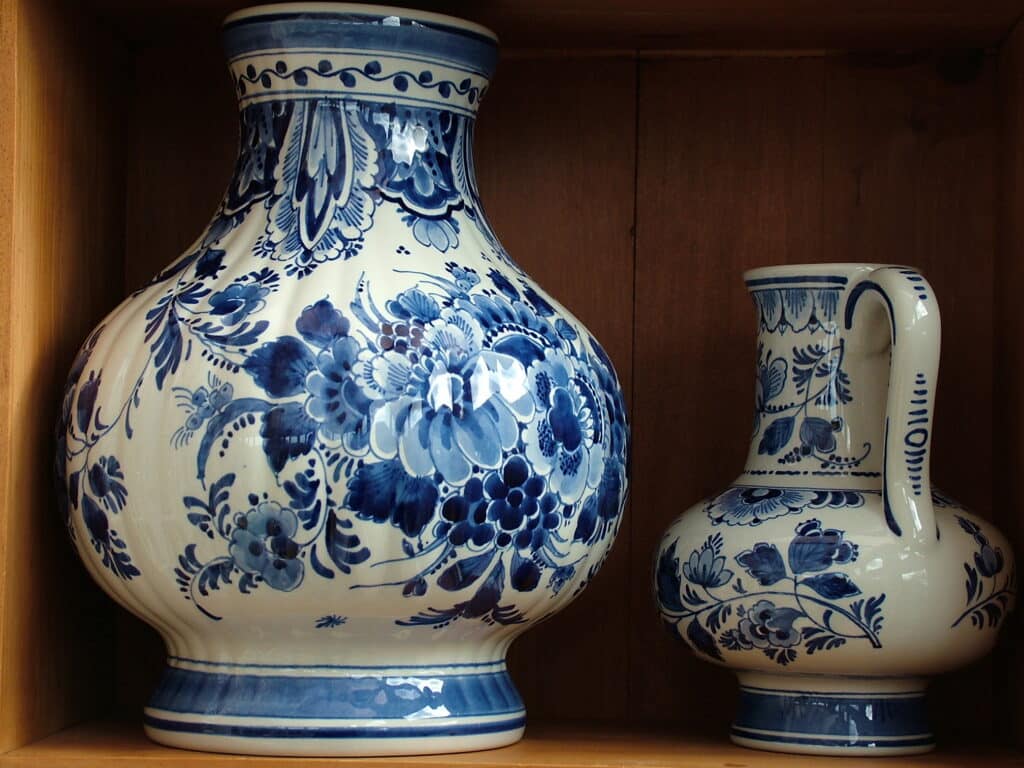If you wish to identify the Delft earthenwareThere are a few things you need to know about it.
All are unbranded.
Even when this is the case, not all these brands are genuine.
So it's useful to know a little about these objets d'art.
Delft earthenware: article summary
Delft earthenware is blue and white
A lot of earthenware from Delft have a white background with hand-painted blue motifs. One of the reasons for this is the history of this art object.
In the early 17ᵉ century, numerous Chinese porcelains ended up on the Dutch ceramics market.
At that time, Chinese porcelain was very popular in the Netherlands. Dutch potters found it difficult to compete with Chinese imports. So, rather than close their doors, Dutch potters began creating imitations of Chinese tableware.
Dutch imitations of Chinese porcelain were convincing and had a beauty all their own. It was this influence of Chinese tableware that led to numerous Delft earthenware pieces with their emblematic blue and white motifs.

The influence of Japanese porcelain
Chinese porcelain was not the only influential factor shaping the color schemes used by Delft potters.
In 1645, there was an interruption in the import of Chinese porcelain to the Netherlands. To replace the flow of porcelain from China, the Dutch ordered their porcelain from Japan.
Japanese porcelain, known as Imari porcelain, is decorated in colors including blue, red and gold. This makes up for the lack of porcelain in the country.
Less decorated porcelain
It should also be remembered that all Delft earthenware was not decorated at all. Many of the earthenware pieces produced by Delft's factories were used as everyday household items.
As such, they were left plain white rather than decorated with the emblematic blue colors of today's Delft earthenware.
An imitation turned city symbol
Early Dutch imitations of Chinese porcelain were strongly influenced by the Chinese style of decoration. As such, Delft earthenware was Chinese in its color schemes and also in the themes it represented.
However, as the Delft potters became more established and skilled in the production of these pieces, they began to include Dutch scenes in the drawings.
These included images of everything from windmills, Dutch landscapes, fishing boats, seascapes, flowers and hunting scenes.
As a result, the decoration of Delft earthenware became a mixture of colors and textures. Chinese styles with European characteristics.
The difficulty of defining Delft earthenware
If you want to identify Delft earthenware, it's useful to look for a mix of Eastern and Western themes.
That said, finding a mix of Dutch and Chinese or Japanese features is no guarantee that you're looking at Delft earthenware.
The Dutch were influenced by Eastern porcelain. But potters in China and Japan were influenced by Dutch tastes.
Because much of their porcelain was exported to the Netherlands, Chinese and Japanese potters produced pieces adapted to the Dutch market.
Stand out from the crowd by selling earthenware rather than porcelain
One of the main differences between Delft earthenware and Chinese and Japanese earthenware is that Delft earthenware is made from earthenware clay. In contrast, the Chinese and Japanese faience it imitated was made from porcelain.
Delft earthenware was sometimes called Delft porcelain, because it sought to copy the appearance of porcelain. Some of the factories that made Delft earthenware had the word "Porcelain" in their name.
And indeed, of the original factories, the one still in operation today is is called La Bouteille de Porcelaine (De Porceleyne Fles).
Nevertheless, Dutch Delft earthenware is made from baked clay. And while fired porcelain is very white and refined, the clay used by Delft potters in the 17ᵉ century was a yellowish-cream color.
If you're looking for real Delft earthenware and you're in Amsterdam, I recommend a detour to the city of the same name. There, you'll find the factories that still manufacture this earthenware. You'll be sure to enjoy an authentic, quality product.
What to do in Amsterdam in 1 day, 2 days, 3 days, 5 days, a week?
Whatever the length of your stay, I invite you to download my special Amsterdam guide.
It's free and in PDF format.
All you have to do is tell me below which e-mail address you'd like to receive it at.
EDIT: you can't enter your email?
Take the quiz at the top of this article and you'll be able to register your email address to receive the special Amsterdam guide!
Leave a Reply